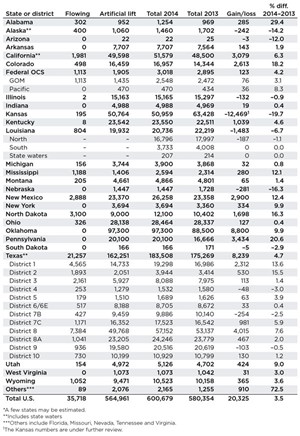Active U.S. oil wells pass the 600,000 mark
The number of producing oil wells in the U.S. rose 3.5% in 2014, to an estimated 600,679. This figure is in line with the 2012-2013 improvement of 3.5%.
Just four U.S. states account for more than half of the country’s active oil wells. Texas continues its place as the leader with the highest number of producing oil wells. Between 2013 and 2014, the Lone Star state saw a 4.7% increase in the total well count to 183,508. Of these, 21,257 flowed under their own pressure, while 162,251 were on some kind of artificial life. District 8 in the Permian basin of West Texas ranked as the most active producing region in the state with 57,152 active wells reported last year. Nearby District 8A came in second with 24,246 wells. While not quite matching 2013’s blistering pace, the state’s well count was still sufficient to almost double that of its closest rival, Oklahoma.
Still a major contender, Oklahoma continues to boast the second highest well count at 97,300 active oil wells. Kansas and California reported just over 50,000 oil wells (though we have some indications the former may be underreported). California, for its part, reversed a declining trend by adding over 3,000 wells, a 6.3% increase.
Among other significant states, North Dakota saw a large percentage increase with its rapidly growing Bakken shale production. The state is now home to some 12,100 oil wells, a 16% jump over the 2013 count of 10,400. Pennsylvania also reported a large percentage increase in the number of oil wells in its mature fields at over 20,000, a rise of some 20%, if revised 2013 figures are accurate.
Three states—Alaska, Kansas and Nebraska—reported significant reductions in the number of active oil wells. On paper, Kansas showed the largest decline at 20%, which may be an artifact of underreporting. In 2013, the state claimed 63,428 active oil wells, but last year this figure dropped to near 50,000. Nebraska experienced the second largest percentage reduction, with a decline of 281 wells (about 16%). Alaska’s oil well count dropped by 242 to 1,460, or 14%.
The number of active producing wells in federal waters increased a reported 4.2% during 2014. In the Gulf of Mexico, the well count increased to 2,548. Of these, 1,113 wells are flowing naturally, while the remaining 1,435 are on artificial lift. The Pacific saw 36 oil wells added to its count, bringing the total to 470. ![]()

- The last barrel (February 2024)
- What's new in production (February 2024)
- E&P outside the U.S. maintains a disciplined pace (February 2024)
- Prices and governmental policies combine to stymie Canadian upstream growth (February 2024)
- U.S. operators reduce activity as crude prices plunge (February 2024)
- U.S. producing gas wells increase despite low prices (February 2024)



